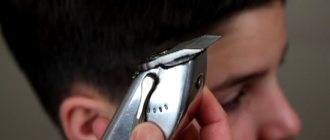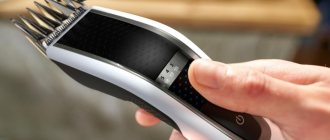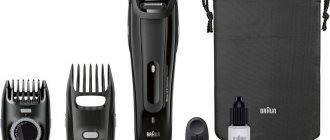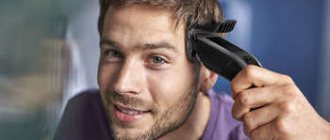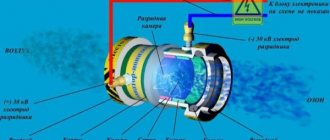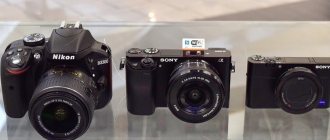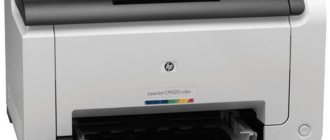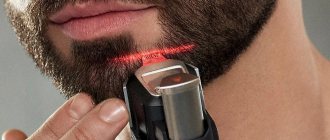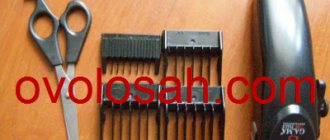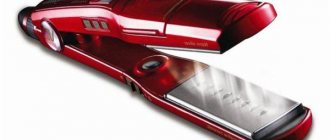A trimmer is a name given to many different devices, including, for example, a device for mowing lawns. The name comes from the English “trim” - haircut, “trimmer” - device for cutting. Even in hairdressing applications, trimmers can also be different. These devices differ in functionality and technology.
One trimmer is a small device, often cylindrical in shape, designed to trim excess hair in the ears and nose (some use it to tidy up their eyebrows). The other looks very similar to a regular hair clipper, but has a number of differences in its technical characteristics and capabilities. Sometimes the future user has no idea how a trimmer differs from a hair clipper. Meanwhile, functionally these are very different devices, each with its own specifics.
What is the difference between a trimmer and a hair clipper?
A hair clipper removes hair to a certain length, which makes it possible to create a certain hairstyle. Unlike a clipper, a trimmer can cut hairs as short as possible, right to the root. Hair can be removed more “cleanly” only with a razor.
Hair clipper shapes hairstyle
Are these two devices interchangeable? Theoretically, you can try to work with one device as if it were two, but you won’t get a decent haircut quality. A machine, even the best one, without a single attachment, does not remove hair “to zero”; stubble of a small length will still remain. You can try to make a haircut with a trimmer by installing attachments on it. But the work will be very hard, and things will go extremely slowly. However, a trimmer is used to trim a beard. There is less hair here, and it is coarse, thick and sparse - a suitable option for a trimmer. As can be seen from the above, a hair clipper and a trimmer cannot be fully used instead of each other.
Hair clipper and beard trimmer. More about the device
Almost all trimmers have a similar design. They resemble a classic hair clipper on the head. The differences are a more compact size and autonomous operation.
The picture above shows a trimmer with a classic shape that can be found in any electronics store. With the help of such a device you can take care of your beard. Autonomy allows you to do it anywhere. The product has a built-in battery.
Beard machines are:
- domestic;
- professional;
- universal.
The most common option is home devices. Most of them operate on battery and mains power. This universal machine is suitable for cutting hair on both the head and face. It can also have a replaceable head for cutting hair in the nose and hard-to-reach places. Professional clippers are used by hairdressers and barbers. As a rule, they operate only from the network and have a longer service life.
To choose the right product, you need to decide on two things: your budget and the tasks that will need to be solved. For precise styling, it is recommended to purchase products with additional functionality (precision additional trimmer, additional laser guidance, vacuum container).
Selection criteria
To select a product, you need to pay attention to the following characteristics:
- food type;
- blade material;
- battery life;
- minimum and maximum hair length left.
It is worth noting that even budget beard clippers have a stainless steel blade. The pitch of the nozzle is also considered a selection criterion. The more positions it can take, the better.
Scope of application of a trimmer in hairdressing
As already mentioned, the trimmer is great for caring for a beard and mustache. You can not only give them shape, but also shave off everything that does not fit into the haircut concept. That is, in this situation you can get by with one device.
The trimmer is ideal for beard and mustache care
The trimmer is widely used as an auxiliary tool when cutting scalp hair. They are used for edging, shaving where necessary, and complex shaped elements.
Technical differences of hairdressing tools
Externally similar, but so different in scope of application, instruments also differ in their technical part.
Knife location
The machine and the trimmer differ from each other in the position of the working knives. This parameter determines how close to the skin the device will touch the hair and cut it. Only a razor works cleaner than a trimmer. Experienced craftsmen often “draw” contours with a trimmer, within which they are already working with a razor.
Working area width
The trimmer has a narrower working head, making it much more convenient for them to work on thin, small details. And that is why cutting all the hair on their heads is a long and tedious task.
Engine and blades
The trimmer, designed, among other things, for working with a beard, has a more powerful motor, and the blades of its knives are made of steel grades with better strength characteristics.
Beard trimmer blade
Facial hair is coarser and thicker. For the “delicate” steel of hairdressing scissors and clipper blades, such hairs are destructive; they instantly dull the working edge. The trimmer copes with the task without reducing the quality of the cut over time. Clippers designed for cutting hair on the head, on the contrary, have a weak motor, but are able to work for quite a long time without overheating.
Definition
A trimmer is a device for removing hair from any part of the body. Allows you to create different hairstyles even in intimate places. Thanks to additional attachments, the trimmer can be used as an electric razor.
Trimmer Panasonic
A hair clipper is a type of small household appliance. It is designed to shorten the hair on the head to the required length. Modern options make it possible to remove a beard or mustache. The machine runs on batteries or mains. Its use is relevant at home.
Philips hair clipper
Types of trimmers
There are models that are designed for beards, noses or mustaches. Universal devices for working with vegetation on different parts of the body have interchangeable attachments.
A head trimmer is mainly used to trim the temples or sideburns.
Special thanks should be given to the inventors of such devices for their help in modeling haircuts, especially in creating unusual designs. For the same task, the unit is also used in intimate areas, where it would definitely be painful and inconvenient to carry out such an operation with a machine. Thus, the technique can also perform the function of a razor.
How to choose
To tell you which trimmer is better to take, you need to know why it is purchased - to create curly haircuts, a beautiful beard, or remove unwanted hair on the body.
In addition to the purpose, consider other parameters.
Model classes
- Professional models are reliable, with a powerful motor, and a large number of attachments. The hairdresser's capabilities are not limited - he can create hairstyles of any shape with any hair length. Withstands long-term continuous use.
- Semi-professional - multifunctional, but inferior to professional ones in terms of build quality, power, and motor performance, which is why they are cheaper.
- Amateur - intended for home use. The motor is low-power with a limited resource, the kit includes a minimum of attachments. If the hair is thick, hard, or if there are several people in the family who often use them, the models may fail faster.
engine's type
The devices most often contain vibration or rotary motors.
- Vibrating.
With the same characteristics, a model with such a motor will cost less than a model with a rotary one. Because such a motor is less powerful (8–20 W), noisier and vibrates in the hand, creating additional load. It is not recommended to use a machine with such a motor for a long time - you need to turn it off every 20-30 minutes to prevent overheating.
- Rotary.
They are quieter, have more power (18–50 W), and do not heat up even after prolonged use with coarse, thick hair. Designed for heavy loads, they can be used to cut both dry and wet hair.
Interesting:
craftsmen prefer to buy 2 models - both with a rotary and a vibration motor.
This expands their capabilities and reduces the load on the hand (a rotary machine is heavier than a vibrating machine, so when there is a large flow of people, the hairdresser can replace it with a vibrating machine). Another point is the shear force, which is provided by the device at high speeds. For rotary engines it is both high, and for vibration engines it depends on the type of mechanism. Thus, vibration motors can have an induction drive (magnetic) or a pivot drive (anchor drive). With magnetic ones, most of the electricity consumed is converted into heat, and a smaller part is spent on operating the knife. That is, they have a low efficiency, since they make many movements per minute - about 6000. Therefore, with their help you can usually only work with dry, clean, thin hair. At the same time, they provide a smooth cut, which is why they are indispensable in fading machines.
With pivot blades, more force is applied to the cut, due to which they heat up less and vibrate less. The average operating frequency is 3000 vibrations per minute. That is, the knives move less often, but more force is applied, which is why it is possible to cope even with complex hair - thick, hard, wet, quickly obtaining a clean cut without antennas. On the other hand, if you apply more force than necessary, you can “take off” too much at once.
There is also a difference in price - models equipped with a pivot motor are more expensive than those sold with a magnetic one, but cheaper than rotary ones.
Power type
- Battery motor. Such machines operate without access to the network, but the operating time is limited - about 75-120 minutes (some manufacturers offer devices that work up to 4 hours), recharging time - from 2 hours. With the same parameters, battery-powered machines are heavier than mains-powered ones due to the weight of the battery itself (and the more capacious it is, the heavier it is). As the charge decreases, the speed of rotation of the knives may also decrease, which affects the quality of the haircut. But some manufacturers are developing technologies that eliminate this drawback. A stand will be convenient to recharge the device without waiting for it to be completely discharged, but it cannot be used with all types of batteries.
- Network. They do not require recharging as they work from the mains. When choosing them, you need to take into account the length of the cord (in professional models it is 2–3 m) and its type. It is better to take a model with a rotating cord so that it does not break during operation.
- Battery-networked. They can operate on battery power or mains power, but are more expensive. On the other hand, you can take them on a business trip, work with them when the electricity is off, or if “circling” around a client with a wire is inconvenient.
Special trimmers for removing hair in the nose, ears, and beards are usually battery-powered or battery-powered. The latter are not designed for long-term operation, therefore they are inferior in power to the battery, but after working out they are easily replaced (no need to wait for them to be recharged).
Battery type
- Ni-MH battery (nickel metal hydride) is more affordable and lighter compared to Li-Ion. But it is not recommended to let it completely discharge, otherwise the “memory effect” will work and the battery capacity will be reduced. By the way, some brands, for example, Moser, have provided a full fast charging function, which is carried out in 2 hours.
- Li-Ion (lithium-ion) - charges faster, lasts longer, due to the fact that the current flows to the board and motor more evenly than in the case of a nickel-metal hydride battery. With irregular use they hardly discharge. Despite the absence of a memory effect, it is not recommended to work with them in a “ragged” rhythm (trimmed a little, put them on charge, picked them up again and put them back on again), as this may affect the life of the battery.
Blades, knife block
The result directly depends on the quality and sharpness of the blade.
- Stainless steel blades are the most affordable and require frequent maintenance - after 2-3 haircuts, they should be lubricated with oil according to the instructions. Otherwise, friction will increase, and the knives may overheat, warp, tear, and not cut hair. There are two disadvantages to stainless steel blades. Firstly, when the machine is used for a long time, they can heat up, causing discomfort to children and people with sensitive skin. Secondly, they are inferior in durability to blades made from other materials. To mitigate these shortcomings, manufacturers can coat them with diamond or titanium coating.
- Ceramic. They cost more, but they cut better than stainless steel blades, as they are sharper. They do not heat up during use. The only drawback is its fragility: if the trimmer is dropped, the ceramic blade will break.
- Titanium. They are durable (titanium is 30% stronger than stainless steel), suitable for cutting wet hair, as they are resistant to corrosion, but are more expensive than analogs made from other materials.
The type of blade ends and the type of knives also matter. Thus, trimmers with rounded blades are produced, which eliminate the risk of skin damage during operation. You can find models with self-sharpening knives - their blades rub against each other while cutting, thereby maintaining their sharpness.
Additional options
- Vacuum cleaning system. It is quite rare, but thanks to the developed technology, it simplifies the cutting process - thanks to the air flow created, the cut hair does not fly away, but is collected.
- Moisture protection, or a removable knife block so that it can be washed under running water.
- Illuminated so as not to miss the “antennas”.
- Battery charge indicator to recharge the device in time.
- Possibility of charging via USB if there is no access to the network.
- Fast charging function for battery models. Some trimmers can be charged for a short time from the stand so that you can finish cutting.
Another useful function is voltage switching in network trimmers. If a person is in Russia or the CIS countries, the device can be connected to a 220 V network, and if in North America - to a 110 V network.
recommended products
NICE EXCEL trolley
Art. 063 E
Closed hairdressing trolley made of durable plastic on wheels...
To order RUR 20,123
STELLITE alloy cutting scissors…
Art. ALLOY-360
Unique steel STELLITE brand of the world famous company DELORO, pr…
Buy for RUB 133,098.
Professional electric mix…
Art. h10907
Professional electric paint mixer. The mixer is designed for…
To order RUB 1,747
Elastic rollerball light with elastic...
Art. 092213252
Elastic light roller with an elastic band for evening hairstyles.
To order 367 rub.
What is better to choose
Ideally, you should purchase both. But when it comes to a specific choice, it is worth setting priorities. If you plan to frequently trim thick and fast-growing hair, then it is best to purchase a clipper.
For model haircuts, you still have to obtain the appropriate knowledge, otherwise you will have to go to a hairdresser to improve the result.
For those people who like to be constantly well-groomed, we can advise you to buy a trimmer. This is especially true for owners of today's fashionable beard. And special attachments will help girls maintain beauty in piquant places without going to a specialized salon, and at the same time develop their imagination in the art of barbering.
